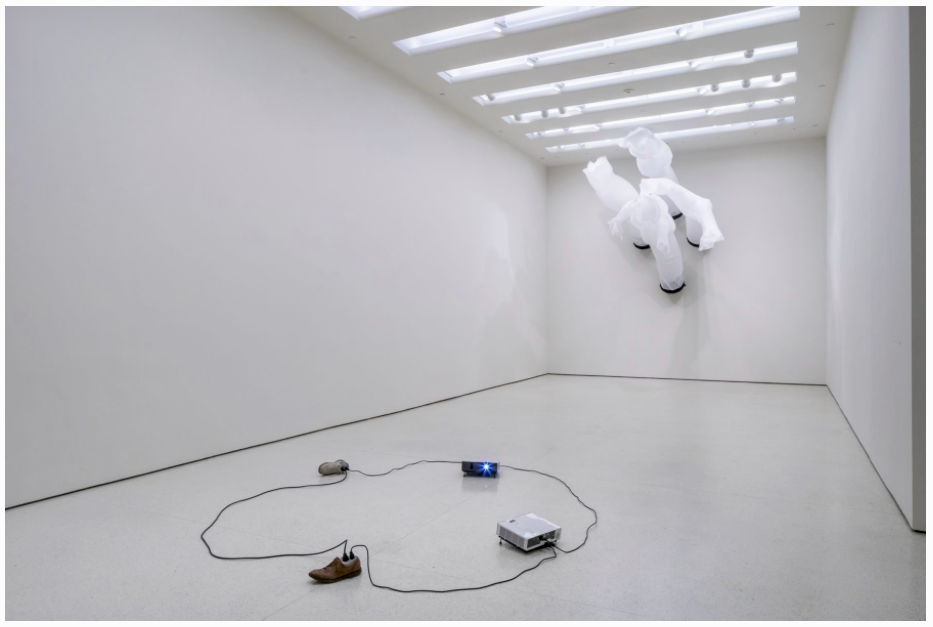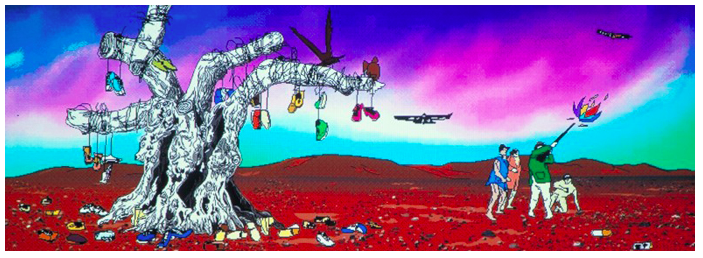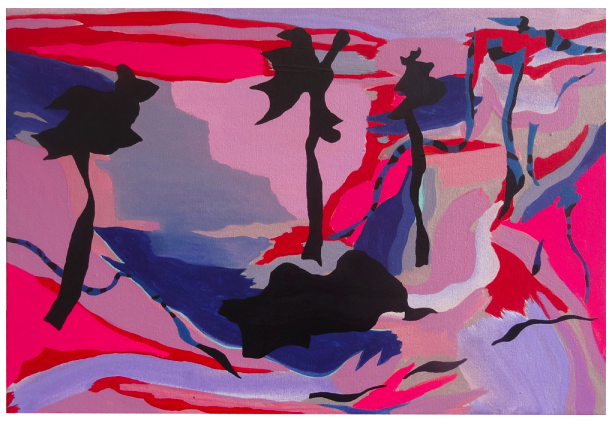On the occasion of three more books being released as part of Badlands Unlimited —artist Paul Chan’s publishing company— series titled New Lovers, we’ve decided to publish an interview done with Chan at the Guggenheim Museum in New York, spring 2015. Having won the 2014 Hugo Boss Prize, an exhibition of new work by Paul Chan was on view from March 6th until May 13th, 2015, titled Nonprojections for New Lovers, installed in one of the galleries off of the main rotunda. Accompanying a sculptural installation, were then prototypes (now published and available) of three paperback books. Tales of erotic fiction, the first three and it can be assumed the next three in the series, expand on the dialogue between the two-dimensional written word and the three-dimensional form that results once bound in a book. Our interview is about the exhibition and the concept of how words, flat when written can become sculptural once published, printed on paper and bound in book form.
KATY DIAMOND HAMER: The first detail that a viewer will notice upon entering the gallery of Nonprojections for New Lovers, is a breeze extending from “Tetra Gummi Phone” (2014-15) a piece made of nylon fabric and fans. Can you talk about the importance of a viewer being present to feel or rather activate this piece?
PAUL CHAN: I think the air is, as you picked up on, important to that piece. Whether or not it’s important for the viewer to pick up on, is not important to me. I’m just happy they are not in prison or dead and that they’ve in fact have found the time and energy to be in that space. I don’t really want to ask anything more of them honestly. People ask others for way too much and I don’t want to be a part of that. It is pleasing to feel the breeze and I think that this work and a few more that I am making with fans, deal with other ways in which we think about projections and how we use something like air to make a kind of projection.

Installation view, The Hugo Boss Prize 2014: Paul Chan, Nonprojections for New Lovers, Solomon R. Guggenheim Museum, New York, 2015, Image courtesy of the Guggenheim and Greene Naftali Gallery
KDH: Projectors on the floor of the gallery are emanating light without an actual image. Similar to the air, the light activates the space and I’m wondering if it’s important to think about the vacancy of the Nonprojections or if one is to wonder about the proposal of what could be a visual image, being that the light source is a projector?
PC: When I started making the Nonprojections I hadn’t made work in a bit of time and one of my thoughts was, how do I do something that isn’t beholden to what I had once done? When we initially met at the Public Art Fund talk in 2008, the type of work I was making then was simply more vivid, simply more there. I cherish those works just as much as anything else done in the past that I feel pleased with, but the past is the past. I wanted to find compositions that are more accommodating and that crystallize how I feel about moving images today. Because in 2002, 2003, when I started making animated projections we were living in a different time. We didn’t necessarily have smart phones with screens that can give us every conceivable moving image that we can commit to. From screens in our pockets to screens on sides of buildings —Times Square is essentially one big moving image— we are now in a time when the moving image is almost ubiquitous. I wanted to find someway to make something pleasing that did not necessarily fit into the continuum of what we understand as our experience with the moving image. In a weird way this is what I came up with. It’s still animated because at the end of the day, you can see light being projected and there is still movement but it’s so reduced, and it enables me to have a new relationship to something called a video projector, a new relationship to a projection and to how those things are actually powered through electricity, such as in the shoes and cords [Play Doh and Die All Jennies 1, both 2013). At the end of the day we are all simply looking for new relationships within ourselves and perhaps the things that we do. This is my way of doing it.
KDH: Mentioning the shoes [placed on the floor], there is this element of absence and humanity where they feel as if they’ve been left or house invisible bodies. The billowing nylon fabric seems to have arms as well which reach out when activated by the air from the fans. Is the figure present for you?
PC: I think that whether or not its present for me, it’s definitely present in the forms. There’s nothing more economical, that manifests a body than a shoe. When you see a shoe on the street, you immediately think, ‘Who owns that shoe?’ It’s almost instantaneous. You don’t need the rest of the body and if there’s only one shoe, your imagination can run wild. I like the economy of that. It fits within the compositional way in which they are being used. The figure is definitely present, whether I want them there or not.

Paul Chan, “My birds . . . trash . . . the future”, 2004, Two-channel video installation, courtesy of Greene Naftali
KDH: The first time I saw your early animations was in Greater New York (2005) at MoMA PS1. You spoke briefly earlier, about the transition of your practice —the two-dimension into the three-dimension— and in between that is text. Could you talk a little about your role with Badlands Unlimited?
PC: Badlands [Unlimited] started in 2010 at a time when I wasn’t making new work and I needed a new reason really and that reason was starting a press. We’ve published over 30 books and our newest books are premiering at the Guggenheim as part of the show. The books are a series of erotic fiction that we published by emerging writers and I think what’s been gratifying about Badlands is that I work with young artists. We think about publishing not in terms of what is being published, but the form that it takes. In the show I’m showing prototypes this series titled New Lovers, because we talked about and thought a lot about the actual physical quality of the paperback and how thick it should be. These are simple things that any publisher will think about but I’d like to think that our sensibility as artists gave us a unique insight into the size, shape, feel and look of the books. Choosing the paper, the debossing, the color at the end of the day what we learned is, like your idea of how text becomes three-dimensional as a book, we realized that the act of reading is not one sense, the eyes but multisensorial. What I remember about the best reading experiences are not only what I read, but how the book was. Who gave it to me, the smell of the paper, the tatters of the cover, where I read it, and I think all of that contributes to how we remember reading.
KDH: It’s sensual.
PC: Right, it’s a full body experience. It’s not just the eyes, even if you just think about the words. We’ve all experienced bad book reading insofar as maybe the font is too big or too small, the margins are off. All of these physical aspects of it contribute to whether or not we “get it”. Again, people in publishing, as a writer you know that, you know when your article or your story looks wrong because the font is wrong, the leading is wrong, you can’t read it.
KDH: Or like a break in a paragraph.
PC: Yes, you break the rhythm. So to me, that’s really about the multisensorial dimension of reading to take advantage of that as artists, publishers, one of my great pleasures has been doing Badlands. Maybe at the end of the day, a good book, puts into your mind moving images that you can really hold on to. It’s just another way of thinking about moving images.
KDH: That’s a great visual.
PC: When we read a good book or even a really bad book, images are conjured in our minds, and who knows where they are. They are not in front of us, they are like ghostly apparitions, but they feel as real as anything and I think those kinds of projections maybe the ones that I hold onto more now. We have screens to give us all we want, but maybe that stuff is something that I want to leave behind, at least for a while.
KDH: Last question, how did you go about finding the three authors?
PC: We found them mostly through friends of friends. It’s like most things, we reached out and said we want to do erotic fiction, do you have friends Then we came up with a sheet asking to send us a pitch for a story and a sample chapter of 2000 words and people started submitting to us and we picked the best ones and started working with them. It’s been a lot of fun.

From the Badlands Unlimited website, announcing the reading of New Lovers at McNally Jackson bookstore, New York
…………………………………………………………………………………………………………………………
An intimate reading with authors Al Bedell, Cara Benedetto and Lex Brown will take place at McNally Jackson, located at 52 Prince Street, on November 19th at 7:00PM. Paul Chan is represented by Greene Naftali gallery in New York.
More soon!
xo

